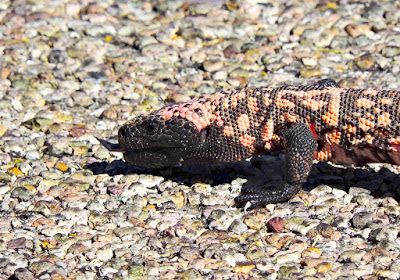 |
| Photos by Bill Kaufman 6/15/2017 |
The Two-tailed Swallowtail is our state butterfly. What a beauty!
[The] Arizona Unicorn Mantis (Pseudovates arizonae) was my most interesting creature. I have never seen one before. It was identified thanks to Margarethe Brummermann. The wings look like a leaf folded around the abdomen, providing great camouflage. This one may be a male. The males have longer antennae and the wings extend past the end of the abdomen (That looks like the case here).
 |
| Photo by Bill Kaufman 6/10/2017 |
 |
| Photos copyright Gene Spesard |
| Photo by Matt Ball June 2017 |
Crossing the bridge to Bear Canyon, we saw a Variable Sandsnake. About ten inches long, this snake spends most of its life buried in sand, gravel, or surface debris which it “swims” through in search of insect prey.
 |
| Photos copyright Dan Weisz 6/11/2017 |
 |
| Photo by Marty Horowitz 6/3/2017 Taken on Mt Lemmon |
 |
| Photos by Marty Horowitz 6/3/2017 |
Base coloration is blue-gray, gray, or gray-brown, often with powder blue or blue-green accents of the body and tail. A dark wedge-shape marks each shoulder and there are dark, bracelet-like crossbars on the forelimbs. Juvenile animals and females often have brown or gray crossbars on the body. Males have a large blue or blue-green patch on each side of the belly and one on the throat. These patches are often outlined with black. Belly and throat patches are faint or lacking in females.
 |
| Photos copyright Marty Horowitz 6/2/2017 |
 |
| All photos copyright Gene Spesard 5/31/2017 |
 |
| Photo by Marty Horowitz 5/31/2017 |
A group of these lizards is called a lounge, which is appropriate since they love to lie around and soak up the sun's rays.Now you know!
 |
| All photos by Marty Horowitz |
 |
| Photo by Marty Horowitz 5/31/2017 |
There is a legend that creosotes inhibit growth of any other plants around them. Not exactly. The roots will excrete a substance which inhibits growth of bursage, its main competitor, and it will also inhibit germination of its own seeds so competing new creosote bushes will not grow nearby. But, the creosote is an important nurse plant for small cacti and many other plants.
Although creosote bushes produce large numbers of fuzzy seeds at each flowering, few of them are able to germinate. It takes decades for creosote bushes to return to areas that have been cleared of native shrubs. Even a one-foot high plant is probably at least ten years old. As the shrub grows, branches continue to originate around the periphery of the original stem crown. The branches grow upward for about six feet giving the whole shrub the rounded shape of an upside down cone.
As growth continues, the oldest branches gradually die and the stem crown splits into separate crowns. This happens at an age of 30 to 90 years. Eventually, the original stem and early branches die and rot away; the connections between adjoining segments of the stem crown thus disappear. The plant has now become a clone, composed of several independent stem crowns all descended from one seedling. The process continues until the clone spreads across the ground in a circular or elliptical shape.
Actually, what botanists classify as a single species in the North American deserts is now known to consist of three genetically different shrubs. Creosote bushes of the Mojave Desert have 78 chromosomes, those of the Sonoran Desert (southern Arizona) have 52 chromosomes, while those of west Texas (Chihuahuan Desert) have only 26. Such an increase in the number of chromosomes in plant evolution is not that unusual. Seedless watermelons, for example, were the result of doubling the number of chromosomes of regular watermelons, the lack of seeds being a side effect. In the case of the Mojave creosote, the increase in chromosome number may have been accompanied by an increasing ability to survive on the less summer rainfall in the Mojave.
 |
| Photo by Karen McWhirter 3/11/2017 |
I took this photo of a bee-fly on March 11th. I had seen what looked like a small bee hovering over the same patch of dirt in my backyard for several days. It occurred to me that it seemed rather odd that I rarely saw it go to any flowers. Searching online for "hovering bees" I learned that it was a Bee-Fly. This fly is in the Bombyliidae family. Though it has a long proboscis for feeding on nectar, they do not sting. The larvae parasitize ground-nesting insects.
Phytoplasmas are very small bacteria that are enveloped only by a single membrane and do not possess a cell wall like typical bacteria. According to results from phylogenetic studies of various genes, phytoplasmas descended from ancestors that did possess walls. In their descent from walled bacteria in the Bacillus/Clostridium group, the genomes of phytoplasmas became greatly reduced in size. Phytoplasmas thus lack some biosynthetic pathways for the synthesis of compounds necessary for their survival, and they must obtain those substances from plants and insects in which they are parasites. Many bacteria can be isolated and grown in artificial media in the laboratory, but so far, no one has been able to accomplish such a feat with any phytoplasma.
Consider yourself lucky to have seen this process. Often the female does not totally submerge herself as appears to be the case with your photos. What happens on species like this is that once the pair is in tandem, the female backs down into the water so that she can deposit the eggs where she wants - on or under or near plant material. The male stays attached throughout the process.